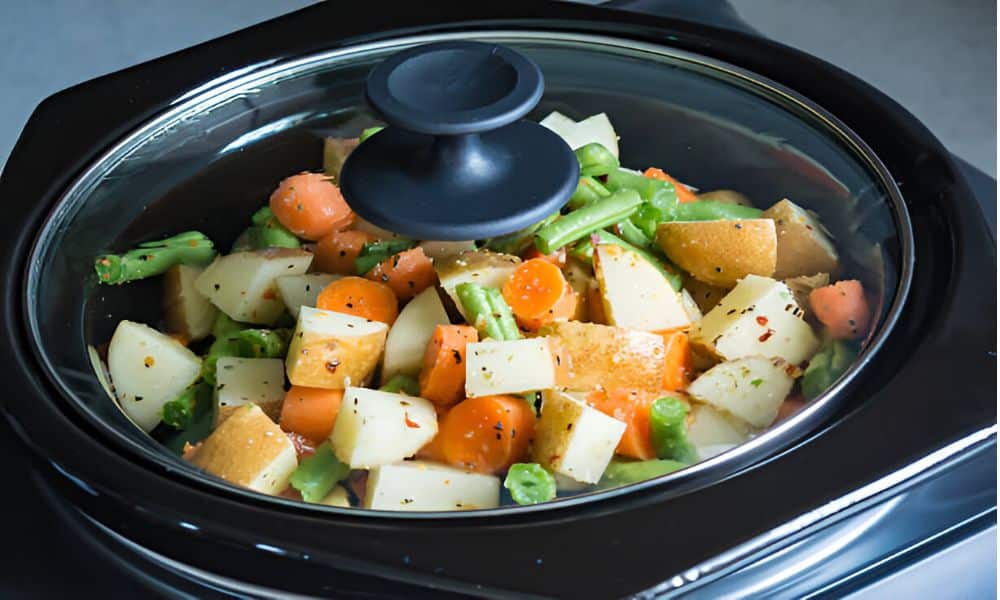Rain tapped the window as I unpacked carrots, potatoes, and beans. A warm pendant light made the counter feel calm. I set my slow cooker on the bench and smiled. I knew supper would take care of itself. Over many home trials, I learned exactly how to cook vegetables in a slow cooker for soft texture and deep taste. The steps are clear, the work is light, the results shine. In this guide, I share simple prep, smart layering, and clean flavors. Grab fresh produce, plug in your cooker, and cook along with me. Dinner will be easy tonight, friend.
Why Use a Slow Cooker for Vegetables?
Slow, steady heat gives even results. Each piece cooks at the same pace. No hot spots. Flavors blend and deepen. Cleanup stays simple.
Gentle heat helps hold nutrients and bright color. Steam stays inside the pot. Less water loss means more taste in every bite. Texture turns tender, not mushy.
Active time drops to almost zero. Load the pot, set the dial, and get on with your day. Beginners gain calm and control. Busy cooks gain freedom.
Compact models shine for small kitchens. The best slow cookers for one person handle side dishes and solo meals with ease. Less space, less waste, same great results.
Choosing the Right Vegetables for Slow Cooking
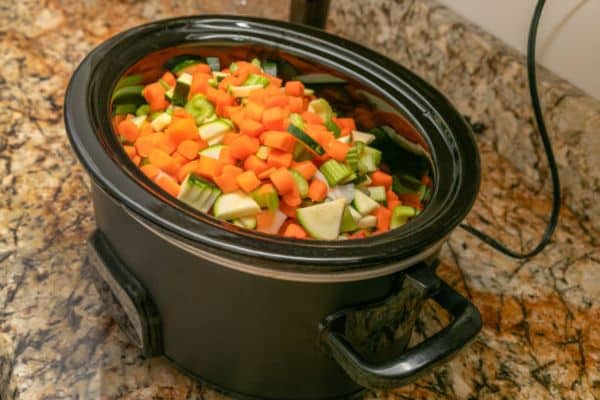
Root vegetables handle slow heat well. Pick firm carrots, potatoes, and parsnips. Cut them into even chunks, about 1 to 1.5 inches. Place at the bottom for steady cooking and full flavor.
Soft vegetables need less time. Zucchini, spinach, and mushrooms turn tender quickly. Keep pieces larger to hold shape. Add near the end for bright color and a fresh taste.
Seasonal vegetables give the best flavor. Spring offers peas and young carrots. Summer brings peppers, tomatoes, and zucchini. Autumn and winter shine with squash, roots, and cabbage. Choose produce that feels firm, looks bright, and smells fresh.
Step-by-Step Guide: How to Cook Vegetables in a Slow Cooker
Step 1 – Select and prep vegetables
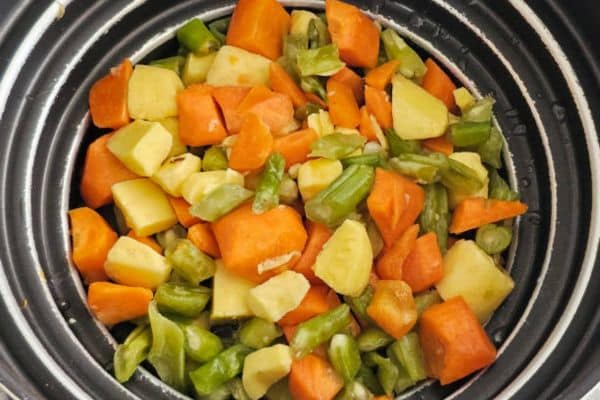
Pick fresh, firm produce. Wash well, peel if needed, and cut into even pieces. This keeps cooking consistent and texture balanced.
Step 2 – Layer smartly
Place dense vegetables like carrots and potatoes at the bottom. Add medium-texture vegetables above them. This helps each type cook at the right pace.
Step 3 – Season well
Add salt, pepper, herbs, or spices before cooking. Early seasoning lets flavors blend slowly.
Step 4 – Add liquid
Use broth or water for moisture and depth. About half to one cup is enough for most recipes.
Step 5 – Set cooking time and temperature
Low heat works well for 5–7 hours. High heat is faster at 2–4 hours. Choose based on your schedule.
Step 6 – Add delicate vegetables later

Greens, zucchini, and mushrooms need less time. Stir them in during the last 30–60 minutes.
Step 7 – Check doneness and adjust seasoning
Test with a fork for tenderness. Taste and add a final pinch of herbs or salt before serving.
My Personal Tips for Perfect Results
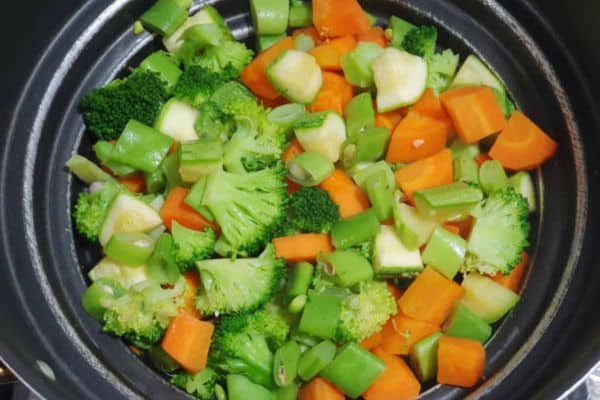
Avoid overfilling the slow cooker. Too many vegetables trap steam and make them watery. Leave space for heat to circulate.
Use broth instead of plain water. Vegetable or chicken broth adds depth and richness that plain water can’t match.
Keep the lid closed during cooking. Each time it’s opened, heat escapes and adds more cooking time. Trust the process.
Taste and adjust in the last 20 minutes. A small pinch of salt, herbs, or a splash of lemon at the end can turn good vegetables into great ones.
Mini Buying Guide: Best Slow Cookers for One Person
For small meals or sides, the best size is 1.5 to 3 quarts. It holds enough vegetables for one or two servings without wasting space or energy.
Choose a model with even heat so each piece cooks the same. Easy-clean inserts like ceramic or nonstick make washing up simple. A keep-warm setting keeps food hot without drying it out.
Good compact choices are the Crock-Pot 2-Quart Manual, Elite Gourmet 1.5-Quart Mini, and Hamilton Beach 3-Quart. Each gives steady heat, simple controls, and strong build for daily cooking.
Not considering cooking time differences between types.
Common Mistakes to Avoid
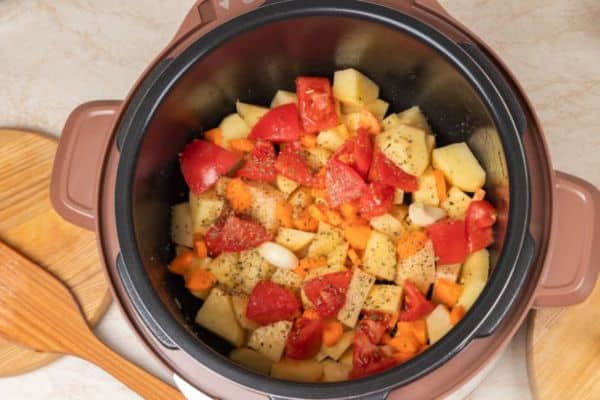
Adding all vegetables at once can lead to uneven texture. Dense roots need more time, while softer vegetables cook faster and can turn mushy.
Using too much liquid waters down flavor. Most vegetables release moisture as they cook, so start with less and adjust if needed.
Cutting uneven pieces causes some parts to overcook while others stay firm. Keep sizes consistent for even results.
Ignoring cooking time differences between types means some vegetables lose their shape. Add delicate ones later to keep color and texture fresh.
Recipe Inspiration for Beginners
Hearty Root Veggie Mix
Combine carrots, potatoes, and onions. Season with rosemary, salt, and pepper. Add a splash of broth and cook on low for 6 hours until tender.
Summer Garden Veggies
Use zucchini, peppers, and cherry tomatoes. Drizzle with olive oil, sprinkle with oregano, and cook on high for 2–3 hours. Add fresh basil before serving.
Autumn Comfort Bowl
Mix butternut squash and sweet potatoes. Season with cinnamon, nutmeg, and a touch of maple syrup. Cook on low for 5–6 hours until soft.
Quick serving ideas
Serve warm with rice, pasta, or crusty bread. Add beans or lentils for extra protein.
Conclusion
Slow cooking makes vegetable prep simple and stress-free. The steady heat builds deep flavor, keeps texture tender, and frees up your time. With just a little prep, you can enjoy warm, nourishing meals without constant attention.
Try your first batch today and taste the difference. Start small, experiment with flavors, and enjoy how easy it feels.
For small homes or solo cooking, the best slow cookers for one person give you fresh, hot vegetables without extra waste. Choose a size that fits your needs, and let your slow cooker turn everyday produce into something special.


